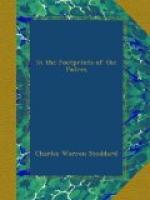There seems to have been a spell cast over the land and the sea. We are sure that Sir Francis Drake did not enter the Bay of San Francisco, and that he had no knowledge of its existence, though he was almost within sight of it. In one of the records of his voyage we read of the chilly air and of the dense fogs that prevailed in that region; of the “white banks and cliffs which lie toward the sea”; and of islands which are known as the Farallones, and which lie about thirty miles off the coast and opposite the Golden Gate.
In 1587 Captain Thomas Cavendish, afterward knighted by Queen Elizabeth, touched upon Cape St. Lucas, at the extremity of Lower California. He was a privateer lying in wait for the galleon laden with the wealth of the Philippines and bound for Acapulco. When she hove in sight there was a chase, a hot engagement, and a capture by the English Admiral. “This prize,” says the historian of the voyage, “contained one hundred and twenty-two thousand pesos of gold, besides great quantities of rich silks, satins, damasks, and musk, with a good stock of provisions.” In those romantic and adventurous days piracy was legalized by formal license; the spoils were supposed to consist of gold and silver only, or of light movable goods.
The next English filibuster to visit the California coast was Captain Woodes Rogers—arriving in November, 1709. He described the natives of the California peninsula as being “quite naked, and strangers to the European manner of trafficking. They lived in huts made of boughs and leaves, erected in the form of bowers; with a fire before the door, round which they lay and slept. Some of the women wore pearls about their necks, which they fastened with a string of silk grass, having first notched them round.” Captain Rogers imagined that the wearers of the pearls did not know how to bore them, and it is more than likely that they did not. Neither did they know the value of these pearls; for “they were mixed with sticks, bits of shells, and berries, which they thought so great an ornament that they would not accept glass beads of various colors, which the English offered them.”
The narrator says: “The men are straight and well built, having long black hair, and are of a dark brown complexion. They live by hunting and fishing. They use bows and arrows and are excellent marksmen. The women, whose features are rather disagreeable, are employed in making fishing-lines, or in gathering grain, which they grind upon a stone. The people were willing to assist the English in filling water, and would supply them with whatever they could get; they were a very honest people, and would not take the least thing without permission.”
Such were the aborigines of California. Captain Woodes Rogers did not hesitate to take whatever he could lay his hands on. He captured the “great Manila ship,” as the chronicle records. “The prize was called Nuestra Senora de la Incarnacion, commanded by Sir John Pichberty, a gallant Frenchman. The prisoners said that the cargo in India amounted to two millions of dollars. She carried one hundred and ninety-three men, and mounted twenty guns.”




